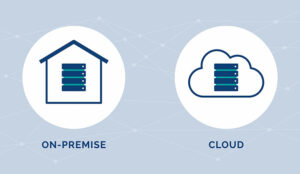Abby Monaco at NICE takes a look at on-premise and cloud computing and explains how to decide which is best for your business and contact centre.
Organizations that are selecting a new contact centre platform have some complex decisions to make. Not only do they need to identify and prioritize functional requirements, but they also need to decide upon on-premise vs. cloud.
In fact, it’s not unusual to settle that debate before businesses start evaluating technology vendors and software functionality.
On-premise versus cloud computing is often a hotly debated topic due to the pros and cons of each option.
On-premise solutions, which are hosted within a business’s own facility, allow businesses to develop their own customizations and implement their own security measures.
However, hosting your own contact centre software can be expensive, and on-premise systems can also be inflexible and not easily scaled.
Cloud software, which is hosted by a vendor and accessed through an internet connection, also has its own strengths and weaknesses. It’s often more flexible, scalable, and cost-effective than on-premise solutions, but the loss of internet service can leave a business and its customers in a bind.
This article is designed to help you sort through the on-premise vs. cloud debate by defining the concepts in more detail and comparing advantages and disadvantages.
The decision about which model is best depends upon each organization’s unique business model and requirements. Having a fundamental understanding of the two options will help you make an informed decision about which one is best for your business and contact centre.
On-Premise Computing
Let’s begin this comparison of the two options by first focusing upon premise-based technology.
Definition of On-Premise Computing
As the name implies, on-premise software is self-hosted by a business on its own hardware and within its own facility. This means the business is responsible for tasks such as:
- Purchasing software licenses
- Installing and testing patches and new releases
- Purchasing, housing, and managing servers and other related hardware
- Maintaining networks
- Managing databases
- Safeguarding systems and data
- Implementing redundancy measures
On-premise contact centre solutions are often associated with legacy systems, but there are still vendors who produce current, on-premise contact centre software.
What Are the Advantages of On-Premise Computing?
On-premise solutions have several noteworthy strengths that may outweigh their weaknesses and make this the right option for an organization. The advantages of on-premise computing include the following:
Complete Control Over Data Security
Data security is an important issue in today’s digital world. A data breach can expose sensitive information and cause an organization to incur hefty fines and take a hit to their reputation.
Because of this, some businesses prefer to have their software housed in their own facilities so that they can implement security measures beyond what even the best cloud service providers use.
Additionally, this prevents third-party bad actors from accessing their data (however, they may still need to contend with their own rogue employees).
Ability to Customize Software
Some businesses have exceptionally unique requirements that can’t be supported by even the most highly configurable cloud solutions.
If these requirements can’t be changed, a business may opt for on-premise systems so they can customize them to meet their specific needs.
Note: While the ability to customize is an advantage of on-premise computing, customizations can also add complexity when installing new releases of the software.
Limited or No Dependency on Internet Connections
While internet connections are becoming faster and more reliable, a natural disaster or a road crew with a backhoe can disrupt connectivity.
While businesses using cloud software may be completely down, on-premise solutions enable organizations to still operate effectively.
What Are the Disadvantages of On-Premise Computing?
Despite some strong advantages, on-premise software has equally strong disadvantages that businesses should consider when evaluating on-premise vs. cloud. These shortcomings include the following:
Inflexible Scaling
When organizations use on-premise solutions, they have to purchase user licenses up front. For example, they may be required to buy a license for every agent seat.
Additionally, they may have limited hardware capacity—just enough to handle typical volume plus some added contingency.
In the case of unplanned volume spikes, it can be difficult to quickly acquire more licenses and add server capacity, which can mean some customers won’t receive the support they need.
Potentially High IT Overhead
Organizations that choose to use on-premise applications need to purchase servers to house the software, plus allocate resources to system and database administration and development.
Additionally, IT staff need to spend incremental time on data security, hardware management, and testing software patches and updates. If an IT team can’t absorb these additional activities, they will need to hire more employees.
Software May Not Include the Latest Innovations
It’s not unusual for businesses to delay applying new software releases, especially if they have customized their on-premise software.
New releases have a reputation (right or wrong) of “breaking” things within the software, so businesses may postpone upgrading until they absolutely need to.
In the meantime, the older software version they’re using doesn’t have the latest innovative functionality they could be using to improve customer experience.
As you can see, an on-premise solution may not provide the flexibility and innovation a business needs to be competitive, but the fact that it can be customized and that organizations can employ their own security measures make on-premise software the right fit for some organizations.
Now let’s take a look at cloud computing.
Cloud Computing
More and more businesses are adopting cloud-based solutions, and the pandemic accelerated the adoption rate because software in a cloud computing environment is easily accessed by remote workers, including at-home contact centre agents.
Let’s dig deeper into what cloud computing is all about before we get into an on-premise vs. cloud comparison.
What Is Cloud Computing?
Cloud computing is the delivery of computer services primarily through the internet. The definition of cloud computing encompasses a broad range of technical services, including infrastructure, development, data storage, and software applications such as cloud contact center platforms.
While most of us are familiar with cloud services in which we access applications through the internet, there are actually different cloud options available.
Private Cloud
A private cloud, also known as a corporate cloud, is hosted and used by a single entity and accessed through a private network.
It essentially allows a business to pool its computing resources to get the biggest bang for the buck. Contact centres that are on a private cloud still have to use on-premise software.
Public Cloud
A public cloud is hosted by a third-party provider and accessed through an Internet connection. The more powerful of these providers use a multi-tenant architecture that can support a multitude of users.
Perhaps the most familiar public cloud service is software as a service (SaaS) and a variation of SaaS called Contact Centre as a Service (CCaaS).
These public cloud options both involve hosted software that is accessed through an internet connection, and will be the focus of the cloud software discussion in the remainder of this article.
Hybrid Cloud
An organization that uses a hybrid cloud solution has some of its software in a private cloud and some in a public cloud, and the applications are typically integrated regardless of which environment they’re in.
Because it’s the most relevant to contact centres, the cloud model we’ll be focusing on in the next sections is the public cloud.
What Are the Advantages of Cloud Computing?
There are many advantages of being in the cloud that account for the substantial shift to cloud computing and away from on-premise solutions. The following are some of the major benefits of the cloud.
Fast and Easy Scalability
While scalability can be a weakness for on-premise systems, it’s a strength of public cloud systems. Cloud software can seamlessly support both planned and unplanned volume increases.
If a sudden crisis causes customer service volume to spike, a CCaaS vendor can quickly add more agent seats for you, and their hardware can very likely handle the additional load.
As a bonus, multi-tenant cloud solution providers typically only charge for what their clients use, so organizations won’t be saddled with expensive, unused licenses when volume gets back to normal.
Supports Business Agility
Seamless scalability isn’t the only way cloud solutions support business agility. Because leading cloud contact centre platforms include a multitude of open APIs, they can easily integrate with other software.
Additionally, implementing other applications offered by your software provider can take just hours instead of weeks or months. For example, if business conditions call for implementing a self-service solution, that can be turned on quickly.
Reduces IT Overhead
When comparing on-premise and cloud solutions, the difference in IT overhead is noteworthy. Because the cloud software provider hosts the application(s), they take care of updates, system testing, data security, hardware management, and other tasks associated with keeping software up and running.
This reduces IT costs and enables IT departments to focus on innovation rather than keeping the lights on.
Easily Enables Remote Work
The pandemic caused a substantial spike in cloud adoption, and that’s because software in a cloud computing environment can be accessed by employees regardless of their location.
This characteristic makes a cloud environment great for business continuity and opens up more labor markets for finding talent.
What Are the Disadvantages of Cloud Computing?
When weighing on-premise vs. cloud, organizations should be aware of the following limitations of cloud-based contact centre software.
Little to No Opportunity to Customize
Unlike on-premise applications in which a software license allows users to customize the software, software in a public cloud environment typically can’t be customized.
Cloud service providers can mitigate this disadvantage by making their solutions highly configurable. For example, users may be able to configure their own complex routing rules and design their own reports.
Dependent on Internet Connection
If a user’s internet connection isn’t consistently strong (at home or in a facility), this can impact the performance of cloud-based software.
And if the connection is completely down, organizations won’t be able to access the applications. Prolonged inability to use the cloud system will degrade the customer experience and may drive up costs if agents are forced to revert to manual processes.
Users Don’t Have Complete Control of Their Own Data
While having complete control of your business’s data is a strength of on-premise systems, it’s a potential disadvantage of using software in a cloud environment.
Industry-leading CCaaS providers overcome this potential weakness by using data security best practices, and you can find some platforms that are compliant with industry data standards, such as PCI and HIPAA. Regardless, this topic should be considered when making an on-premise vs. cloud decision.
Comparison Between On-Premise and Cloud Computing
Let’s sum up some of this information in an on-premise vs. cloud computing comparison.
Cost of On-Premise vs. Cloud
With on-premise software, users need to purchase items such as software and database licenses, hardware, and development and testing environments, as well as pay for IT staff to manage it.
Software licenses and hardware are typically capitalized, and their depreciation is carried on the books for several years.
Users typically need to purchase software licenses for the peak amount of forecasted volume, which means licenses can go unused during slower times of the business cycle.
In contrast, fees paid to cloud software providers are typically accounted for as operating expenses. And because those fees flex with consumption, cloud is often a more cost-effective option than on-premise software.
Additionally, because the third-party provider hosts the software, there is significantly lower IT overhead, as previously discussed.
As a bonus, businesses that use cloud systems never have the unplanned expense of replacing a server that suddenly fails, making cloud expenses more predictable.
Security of On-Premise vs. Cloud
With on-premise systems, businesses are responsible for keeping data secure. That can be an attractive characteristic for organizations that have the resources and expertise, as well as a critical need to implement data security measures beyond what a cloud software vendor provides.
However, for other organizations who don’t have the internal expertise, handling data security on their own may introduce risk.
On the other hand, being in the cloud adds some data security risk, but cloud software can be highly secure if you choose the right cloud service provider.
Software vendors have teams of data security experts that focus on safeguarding data. Additionally, compliance with industry standards ensures that third-party auditors have assessed their data security practices. However, clients aren’t able to implement their own measures.
Control and Customization of On-Premise vs. Cloud
As discussed, one of the advantages of using on-premise software is that it can typically be customized to support the users’ specific needs.
However, customizations aren’t normally supported by the vendor and can make implementing software upgrades more complex.
Cloud contact centre software usually can’t be customized, but industry-leading solutions typically include a multitude of configuration options.
And, since CCaaS applications are based on contact centre best practices, transitioning to the cloud can be a terrific opportunity for businesses to revamp processes and avoid the need to customize.
Scalability of On-Premise vs. Cloud
When comparing scalability of on-premise vs. cloud, cloud wins. Adding capacity to software in the cloud is simple and can be done within hours, if not minutes.
In contrast, scaling on-premise applications may require purchasing more licenses and additional server capacity. The advantage of quick and easy scalability can be the deciding factor in choosing which type of platform to use.
Factors to Consider When Choosing Between On-Premise and Cloud Computing
All of the advantages and disadvantages we just discussed should factor into which option is best for your organization. Additionally, you may want to consider:
- Your time frame. If you have a short time frame for implementing a new contact centre platform, a cloud solution is probably your best option.
- Existing IT resources and skills. Does your organization already have internal resources and capacity to support a new system? How about existing data security expertise? An analysis of current IT skills and resources should be part of an on-premise vs. cloud decision.
- Your budget. Your implementation and ongoing operating budgets may also drive your decision about which option is best. Create a three- to five-year financial forecast of each option so you can compare the numbers and see which one best fits your budgetary constraints.
You should also consider that more and more businesses are moving away from on-premise software and towards the cloud.
For example, Gartner projects that spending on public cloud services will increase by 20.7% in 2023. That’s on top of an 18.8% forecasted growth rate the prior year. That’s a steep trajectory!
Cloud computing isn’t a thing of the future. It’s what today’s industry leaders are using to create the agility needed to quickly capitalize on emerging business opportunities.
This blog post has been re-published by kind permission of NICE – View the Original Article
For more information about NICE - visit the NICE Website
Call Centre Helper is not responsible for the content of these guest blog posts. The opinions expressed in this article are those of the author, and do not necessarily reflect those of Call Centre Helper.
Author: NICE
Published On: 3rd Oct 2023 - Last modified: 9th Dec 2024
Read more about - Guest Blogs, NICE






 NICE is a leading global enterprise software provider that enables organizations to improve customer experience and business results, ensure compliance and fight financial crime. Their mission is to help customers build and strengthen their reputation by uncovering customer insight, predicting human intent and taking the right action to improve their business.
NICE is a leading global enterprise software provider that enables organizations to improve customer experience and business results, ensure compliance and fight financial crime. Their mission is to help customers build and strengthen their reputation by uncovering customer insight, predicting human intent and taking the right action to improve their business. 































